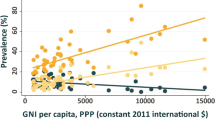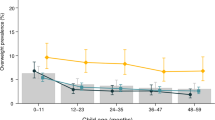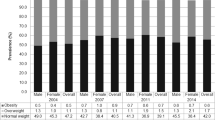Abstract
Background:
Overweight prevalence has increased globally; however, current time trends of overweight prevalence by social class in lower income countries have not been fully explored.
Methods:
We used repeated cross-sectional, nationally representative data from the Demographic and Health Surveys on women aged 18–49 years with young children (n=421 689) in 39 lower-income countries. We present overweight (body mass index⩾25 kg m−2) prevalence at each survey wave, prevalence difference and prevalence growth rate for each country over time, separately by wealth quintile and educational attainment. We present the correlation between nation wealth and differential overweight prevalence growth by wealth and education.
Results:
In the majority of countries, the highest wealth and education groups still have the highest prevalence of overweight and obesity. However, in a substantial number of countries (14% when wealth is used as the indicator of socioeconomic status and 28% for education) the estimated increases in overweight prevalence over time have been greater in the lowest- compared with the highest-wealth and -education groups. Gross domestic product per capita was associated with a higher overweight prevalence growth rate for the lowest-wealth group compared with the highest (Pearson's correlation coefficient: 0.45).
Conclusions:
Higher (vs lower) wealth and education groups had higher overweight prevalence across most developing countries. However, some countries show a faster growth rate in overweight in the lowest- (vs highest-) wealth and -education groups, which is indicative of an increasing burden of overweight among lower wealth and education groups in the lower-income countries.
This is a preview of subscription content, access via your institution
Access options
Subscribe to this journal
Receive 12 print issues and online access
$259.00 per year
only $21.58 per issue
Buy this article
- Purchase on Springer Link
- Instant access to full article PDF
Prices may be subject to local taxes which are calculated during checkout





Similar content being viewed by others
References
Popkin BM . The World Is Fat: The Fads, Trends, Policies, and Products That Are Fattening the Human Race. Avery-Penguin Group: New York, 2008.
Popkin BM . Global nutrition dynamics: the world is shifting rapidly toward a diet linked with noncommunicable diseases. Am J Clin Nutr 2006; 84: 289–298.
Popkin BM, Conde W, Hou N, Monteiro C . Is there a lag globally in overweight trends for children compared with adults? Obesity (Silver Spring) 2006; 14: 1846–1853.
Subramanian S, Perkins JM, Ozaltin E, Davey Smith G . Weight of nations: a socioeconomic analysis of women in low- to middle-income countries. Am J Clin Nutr 2011; 93: 413–421.
Subramanian S, Perkins JM, Khan KT . Do burdens of underweight and overweight coexist among lower socioeconomic groups in India? Am J Clin Nutr 2009; 90: 369–376.
de Brauw A . Migration and child development during the food price crisis in El Salvador. Food Pol 2011; 36: 28–40.
Sen A . The rich get hungrier. The New York Times 2008; 28.
Phelan JC, Link BG, Diez-Roux A, Kawachi I, Levin B . ‘Fundamental causes’ of social inequalities in mortality: a test of the theory. J Health Soc Behav 2004; 45: 265–285.
Mackenbach JP, Stirbu I, Roskam A-JR, Schaap MM, Menvielle G, Leinsalu M et al. Socioeconomic inequalities in health in 22 European countries. N Engl J Med 2008; 358: 2468–2481.
Link BG, Phelan J . Social conditions as fundamental causes of disease. J Health Soc Behav 1995; Spec No: 80–94.
Yach D, Hawkes C, Gould CL, Hofman KJ . The global burden of chronic diseases. JAMA 2004; 291: 2616–2622.
Popkin BM . Will China's nutrition transition overwhelm its health care system and slow economic growth? Health Aff 2008; 27: 1064–1076.
Ezzati M, Hoorn S, Lawes C, Leach R, James W, Lopez A et al. Rethinking the diseases of affluence paradigm: global patterns of nutritional risks in relation to economic development. PLoS Med 2005; 2: e133.
Monteiro CA, Conde WL, Popkin BM . Income-specific trends in obesity in Brazil: 1975–2003. Am J Public Health 2007; 97: 1808–1812.
Ziraba A, Fotso J, Ochako R . Overweight and obesity in urban Africa: a problem of the rich or the poor? BMC Public Health 2009; 9: 465.
Jones-Smith JC, Gordon-Larsen P, Siddiqi A, Popkin BM . Cross-national comparisons of time trends in overweight inequality by socioeconomic status among women using repeated cross-sectional surveys from 37 developing countries, 1989–2007. Am J Epidemiol 2011; 173: 667–675.
Demographic and Health Surveys. DHS Model Questionnaires. MEASURE DHS. Macro International: Calverton, 2008.
Demographic and Health Surveys. DHS Guidelines for Interviewer Training. MEASURE DHS. Macro International: Calverton, 2000.
WHO/FAO. Expert Consultation on Diet, Nutrition and the Prevention of Chronic Diseases: Report of the Joint WHO/FAO Expert Consultation. World Health Organization: Geneva, 2003.
Rutstein SO, Johnson K, Macro O . The DHS Wealth Index. ORC Macro, MEASURE DHS, 2004.
Fernald LCH, Gertler PJ, Neufeld LM . Role of cash in conditional cash transfer programmes for child health, growth, and development: an analysis of Mexico's Oportunidades. Lancet 2008; 371: 828–837.
World Bank. EdStat Indicators. http://web.worldbank.org/WBSITE/EXTERNAL/TOPICS/EXTEDUCATION/EXTDATASTATISTICS/EXTEDSTATS/0,contentMDK:21272698~menuPK:4323930~pagePK:64168445~piPK:64168309~theSitePK:3232764,00.html (accessed December 2009).
World Bank. World Development Indicators. http://ddp-ext.worldbank.org/ext/DDPQQ/member.do?method=getMembers&userid=1&queryId=6 (accessed 1 December 2009).
Ahmad O, Boschi-Pinto C, Lopez A, Murray C . Age Standardization of Rates: A New WHO Standard. GPE Discussion Paper Series, No. 31. World Health Organization: Geneva, 1999.
Wagstaff A, Paci P, van Doorslaer E . On the measurement of inequalities in health. Soc Sci Med 1991; 33: 545–557.
WHO Expert Consultation. Appropriate body-mass index for Asian populations and its implications for policy and intervention strategies. Lancet 2004; 363: 157–163.
Sterne J, Smith G, Cox D . Sifting the evidence—what's wrong with significance tests? Another comment on the role of statistical methods. BMJ 2001; 322: 226.
Sobal J, Stunkard AJ . Socioeconomic status and obesity: a review of the literature. Psychol Bull 1989; 105: 260–275.
Monteiro CA, Conde WL, Lu B, Popkin BM . Obesity and inequities in health in the developing world. Int J Obes Relat Metab Disord 2004; 28: 1181–1186.
Ashford LS, Haub C, Kent MM, Yinger NV . Transitions in World Population. Population Reference Bureau: Washington, DC, 2004.
Acknowledgements
This work was supported by the National Institute of Child Health and Human Development at the National Institutes of Health (NRSA T32 HD07168-30 and 31, R01-HD30880, and R01-HD38700).
Author information
Authors and Affiliations
Corresponding author
Ethics declarations
Competing interests
The authors declare no conflict of interest.
Additional information
Supplementary Information accompanies the paper on International Journal of Obesity website
Supplementary information
Rights and permissions
About this article
Cite this article
Jones-Smith, J., Gordon-Larsen, P., Siddiqi, A. et al. Is the burden of overweight shifting to the poor across the globe? Time trends among women in 39 low- and middle-income countries (1991–2008). Int J Obes 36, 1114–1120 (2012). https://doi.org/10.1038/ijo.2011.179
Received:
Revised:
Accepted:
Published:
Issue Date:
DOI: https://doi.org/10.1038/ijo.2011.179
Keywords
This article is cited by
-
Lung function and atherosclerosis: a cross-sectional study of multimorbidity in rural Uganda
BMC Pulmonary Medicine (2022)
-
Overweight Syndrome, a Deviation from Normalcy: a Multiple Risk Factor Analysis Among Reproductive Age Group (15–49) Women in Indian Context
Global Social Welfare (2022)
-
Interventions to prevent obesity in Latinx children globally: protocol for a systematic review and meta-analysis
Systematic Reviews (2021)
-
The future of human malnutrition: rebalancing agency for better nutritional health
Globalization and Health (2021)
-
Differences in magnitude and rates of change in BMI distributions by socioeconomic and geographic factors in Mexico, Colombia, and Peru, 2005–2010
European Journal of Clinical Nutrition (2020)



